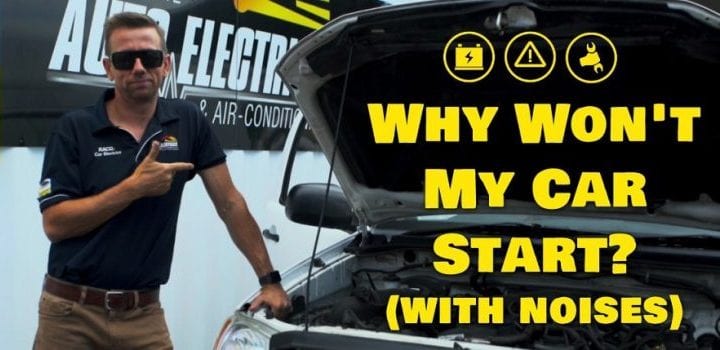So your car won’t start, but it’s making some noises? Here are some samples of noises and causes so that you can identify them. Hi, I’m Andrew from Accelerate Auto Electrics. We’ve all been in this situation where you’re in a frantic rush, you’re running late, finally jump in the car, and the car won’t start.
So today, we’re gonna take my old Hilux. We’ve had this girl for a while. We’re gonna break it, the unbreakable Hilux, and make some noises, and show you what they mean and the causes of them. So to do this today, and to help me, I’m gonna need my beautiful assistant, Briohny. Here she is. Excuse the sunnies. It’s very bright here. And we’re gonna stick her in the driver’s seat, and she’s gonna be my cranker.
So, we’ve got my old HiLux, 2.7 litre, four-cylinder, this engine’s been around for ages. We all know the noise it should make, which is…
(engine starts up normally)
Thank you. So, basically, that’s what it should sound like. You’ll hear the starter motor initially crank over quite well, and the engine fire within three or four RPM. So that’s really what you’re looking for, and when you don’t get it, let’s go through some now.
Is it the Starter Motor?
Okay. What we’ve done here is we’re simulating a starter motor in this one. There are two real things that go wrong starter motors. The old one that everybody talks about is the solenoid. A solenoid’s got contacts. It’s a plunger that comes down and it makes a loud click. The click sounds like this…
(solenoid clicks repeatedly)
Okay. So what happens if you get in your car, you hear that loud solid click, that’s generally either starter contacts, or a battery terminal, which is how I simulated it. The other thing that goes wrong with a starter motor is when they run out of brushes, in which case you won’t get anything. You’ll just have your dash lights on, you’ll turn the key, you won’t actually hear anything because the solenoid’s not making contact through. But that loud click is probably the most common one, and you generally get that on anything with a reduction drive starter motor, so all the Toyotas, a lot of Mitsubishis, and so on. So that’s one down.
Is it the Battery?
Alright, so what we’ll do now is we’ll show you basically what a flat battery sounds and looks like, actually. So, what we’ll do– Briohny, crank away…
(engine tries to start)
Cool. As you can hear, it didn’t start, and it made that sluggish sound, and then the machine gun sound. The sluggish sound is the battery low in charge, and then once it does that machine gun, it’s actually not enough power to engage the solenoid that we were talking about before.
So the solenoid’s clicking in and out. Another good check, if it makes that noise and you really want to make sure it’s the battery, is just turn the headlights on, and you’ll notice they’re quite slow to come on, and they’re quite an orange colour. That orange colour gives away that you’ve also got low voltage going, so definitely a flat battery. In this case, jump start it and away she’ll go. If the alternator is working fine, it’ll charge back up. We’d then recommend putting it on a battery charger, getting it fully charged, and testing it.
Is it the Alternator?
Okay, so before when we had the flat battery, we also spoke about the alternator recharging the battery. So, there’s no real audible noise if your alternator fails, but generally, you’ll get an alternator warning light. So what we’ll do is simulate a warning light. It’s actually the battery light, and a lot of people get a bit confused with this. They see the battery light, they think it’s a battery fault, but it’s actually an alternator fault.
So if your alternator light’s on, your battery’s not charging, and either your vehicle will stop with a flat battery or when you pull up, you’ll try and start it and you’ll get the flat battery noise before. So we’ll show you what the alternator light looks like.
So I really hope that helped you today with a couple of noises and a few checks to carry out if your car won’t start. Although it’s always handy to understand what is happening with your car, situations are not always a cut and dry diagnosis. We always recommend getting your vehicle professionally diagnosed by an auto electrician, and that way you won’t run into any surprises along the way.
Get in touch with us on 1300 227 353, or email info@amae.net.au.

